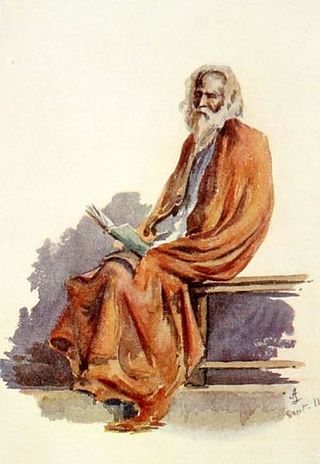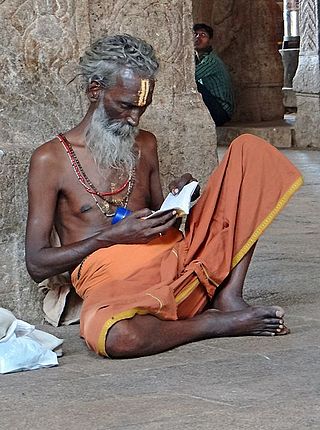
Dharma is a key concept with multiple meanings in the Indian religions, among others. The term dharma is held as an untranslatable into English ; it is understood to refer to behaviours which are in harmony with the "order and custom" that sustains life; "virtue", or "religious and moral duties". The antonym of dharma is adharma.
Gṛhastha literally means "being in and occupied with home, family" or "householder". It refers to the second phase of an individual's life in a four age-based stages of the Hindu asrama system. It follows celibacy life stage, and embodies a married life, with the duties of maintaining a home, raising a family, educating one's children, and leading a family-centred and a dharmic social life.
Brahmacharya is a concept within Indian religions that literally means "conduct consistent with Brahman" or "on the path of Brahman". Brahmacharya, a discipline of controlling the senses, is seen as a way to liberation. Though sexual restraint is a part of brahmacharya, brahmacharya encompasses all striving toward a passionless state.

Sannyasa, sometimes spelled sanyasa, is the fourth stage within the Hindu system of four life stages known as ashramas, the first three being brahmacharya, grihastha (householder) and vanaprastha. Sannyasa is traditionally conceptualized for men or women in the last years of their life, but young brahmacharis have the choice to skip the householder and retirement stages, renounce worldly and materialistic pursuits and dedicate their lives to spiritual pursuits.
Āpastamba Dharmasūtra is a Sanskrit text and one of the oldest Dharma-post vedic smriti related texts of Hinduism that have survived into the modern age from the 1st millennium BCE. It is one of three extant Dharmasutras texts from the Taittiriya school which is relatively newer in comparison to Maitrayaniya shakha of Krishna Yajurveda, the other two being Baudhayana Dharmasutra and Hiranyakesin Dharmasutra.
Dharmaśāstra are Sanskrit Puranic Smriti texts on law and conduct, and refer to treatises (śāstras) on Dharma. Like Dharmasūtra which are based upon Vedas, these texts are also elaborate law commentaries based on vedas, Dharmashastra themselves evolved from dharmshutra. There are many Dharmashastras, variously estimated to number from 18 to over 100. Each of these texts exists in many different versions, and each is rooted in Dharmasutra texts dated to the 1st millennium BCE that emerged from Kalpa (Vedanga) studies in the Vedic era.
Artha is one of the four goals or objectives of human life in Hindu traditions. It includes career, skills, health, wealth, prosperity and the means or resources needed for a fulfilling life. The word artha literally translates as "meaning, sense, goal, purpose or essence" depending on the context. Artha is also a broader concept in the scriptures of Hinduism, Buddhism and Jainism. As a concept, it has multiple meanings, all of which imply "means of life", activities and resources that enable one to be in a state one wants to be in.
Purushartha literally means "object(ive) of men". It is a key concept in Hinduism, and refers to the four proper goals or aims of a human life. The four puruṣārthas are Dharma, Artha, Kama and Moksha.
The following list consists of notable concepts that are derived from Hindu culture and associated cultures’ traditions, which are expressed as words in Sanskrit or other Indic languages and Dravidian languages. The main purpose of this list is to disambiguate multiple spellings, to make note of spellings no longer in use for these concepts, to define the concept in one or two lines, to make it easy for one to find and pin down specific concepts, and to provide a guide to unique concepts of Hinduism all in one place.

Samskara are sacraments in Hinduism and other Indian religions, described in ancient Sanskrit texts, as well as a concept in the karma theory of Indian philosophies. The word literally means "putting together, making perfect, getting ready, to prepare", or "a sacred or sanctifying ceremony" in ancient Sanskrit and Pali texts of India.
Dvija means "twice-born". The concept is premised on the belief that a person is first born physically and at a later date is born for a second time spiritually, usually when he undergoes the rite of passage that initiates him into a school for Vedic studies. The term also refers to members of the three varnas in the traditional Hindu social system, or social classes — the Brahmins, Kshatriyas (warriors), and Vaishyas — whose samskara of the Upanayana initiation was regarded as a second or spiritual birth.
Āśrama is a system of stages of life discussed in Hindu texts of the ancient and medieval eras. The four asramas are: Brahmacharya (student), Gṛhastha (householder), Vanaprastha, and Sannyasa (renunciate).
Prāyaścitta is the Sanskrit word which means "atonement, penance, expiation". In Hinduism, it is a dharma-related term and refers to voluntarily accepting one's errors and misdeeds, confession, repentance, means of penance and expiation to undo or reduce the karmic consequences. It includes atonement for intentional and unintentional misdeeds. The ancient Hindu literature on repentance, expiation and atonement is extensive, with earliest mentions found in the Vedic literature. Illustrative means to repent for intentional and unintentional misdeeds include admitting one's misdeeds, austerities, fasting, pilgrimage and bathing in sacred waters, ascetic lifestyle, yajna, praying, yoga, giving gifts to the poor and needy, and others.
The Vashistha Dharmasutra is one of the few surviving ancient Sanskrit Dharmasutras of Hinduism. It is reverentially named after a Rigvedic sage Vashistha who lived in the 2nd millennium BCE, but the text was probably composed by unknown authors between 300 BCE – 100 CE. It forms an independent text and other parts of the Kalpasūtra, that is Shrauta- and Grihya-sutras are missing. It is written in sutra style, and contains 1,038 sutras. According to Patrick Olivelle – a professor of Sanskrit and Indian religions, the text may be dated closer to the start of the common era, possibly the 1st century, since it uses the pronoun "I" and a style as if the text is a personal teaching guide, and because it is the oldest Indian text that mentions "the use of written evidence in judicial proceedings".
The Samavartana, also known as Snāna, is a rite of passage in the ancient texts of Hinduism. Performed at the close of the Brahmacharya period, it marks the graduation of a student from Gurukul (school). It signifies a person's readiness to enter grihastashrama.

Law in India primarily evolved from customary practices and religious prescriptions in the Indian subcontinent, to the modern well-codified acts and laws based on a constitution in the Republic of India. The various stages of evolution of Indian law is classified as that during the Vedic period, the Islamic period, the British period and post independence.

Aruneya Upanishad is a minor Upanishad in the corpus of the 108 Upanishads of Hinduism. It is written in Sanskrit. It is one of the 16 Upanishads attached to the Samaveda. It is classified as a Sannyasa Upanishad.

The Jabala Upanishad, also called Jabalopanisad, is a minor Upanishad of Hinduism. The Sanskrit text is one of the 20 Sannyasa Upanishads, and is attached to the Shukla Yajurveda.

The Naradaparivrajaka Upanishad is a medieval era Sanskrit text and one of the minor Upanishads of Hinduism. The text is attached to the Atharva Veda, and is one of the 20 Sannyasa (renunciation) Upanishads.
In Hinduism, Śāstra pramāṇam refers to the authority of the scriptures with regard to puruṣārtha, the objects of human pursuit, namely dharma, artha, kāma (pleasure) and mokṣa (liberation). Together with smṛti, ācāra, and ātmatuṣṭi, it provides pramana and sources of dharma, as expressed in Classical Hindu law, philosophy, rituals and customs.







